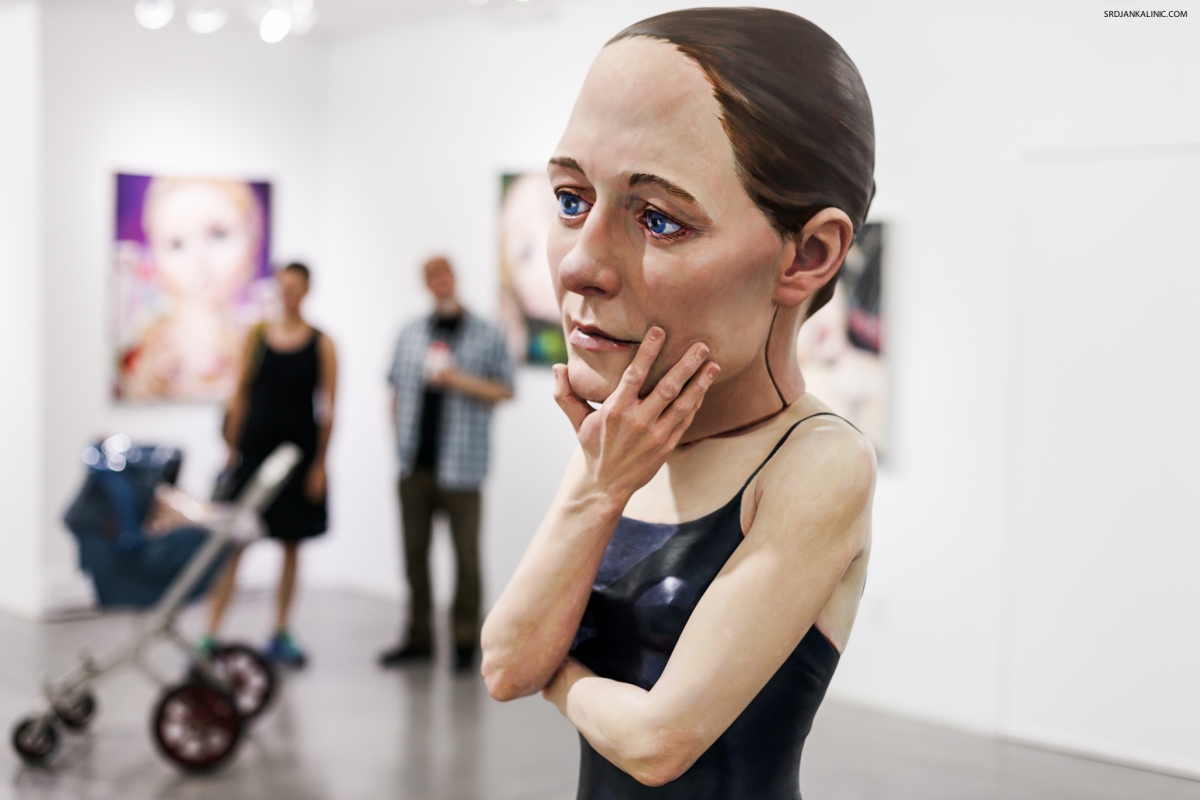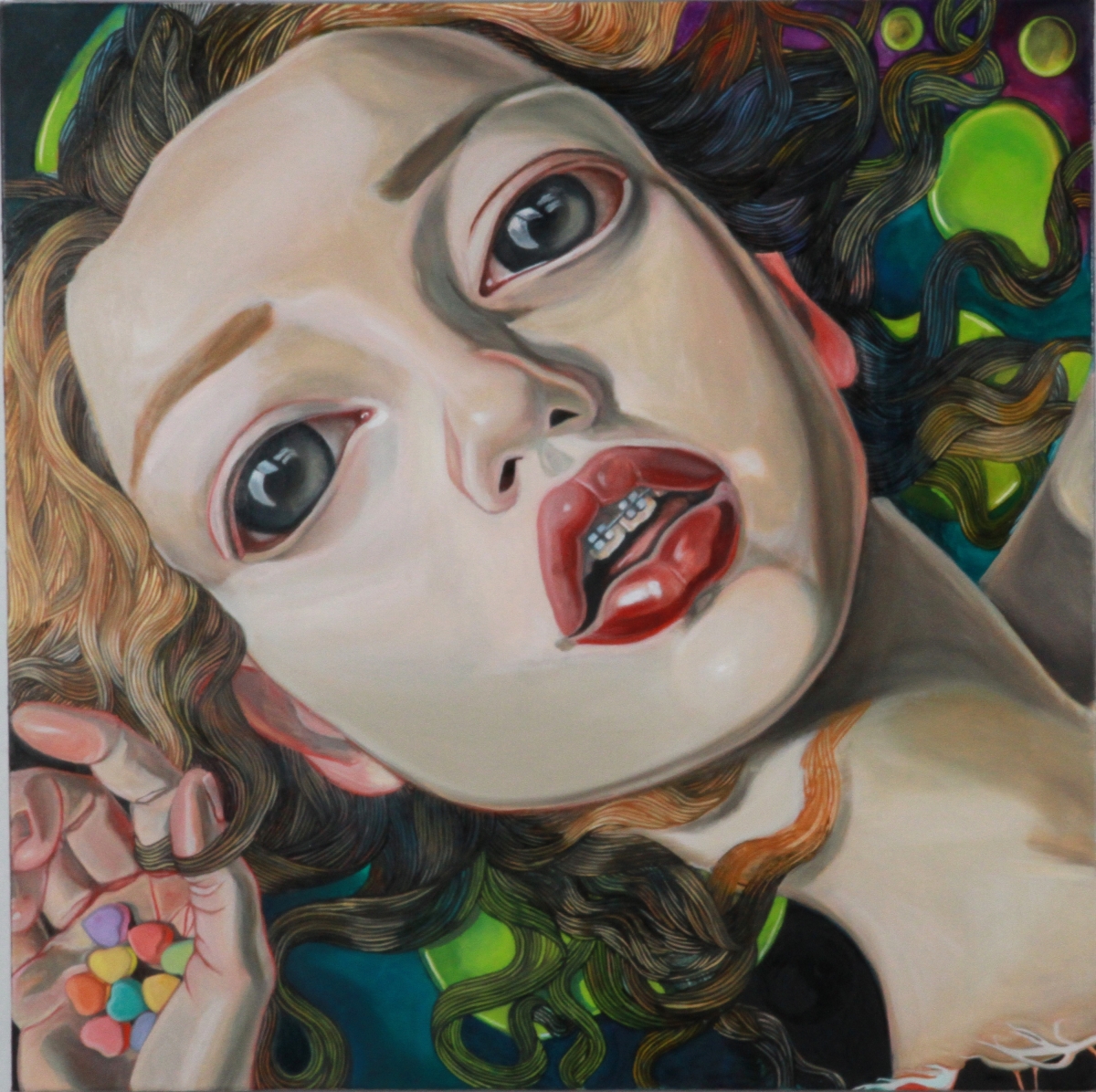
Head, a new exhibition at BOSI Contemporary, orbits eccentrically around the notion of the human head as an avatar for the human condition. Curators D. Dominick Lombardi and Robert Curcio have gathered 36 idiosyncratic examples of the head as social signifier, troubled mask, and dream-like presence. The eleven artists represented here unsettle us with their evocations of head as the repository of the psyche which demands to make itself known.
The spirit of the show is embodied in Nina Levy's hyper-realist sculpture of a standing woman in a little black dress, one hand clutched across her body, the other thoughtfully cradling her chin. "Spectator" is the perfect gallery goer, except for a monstrously large head which covers her own – the self-conscious ego worn like the costume of a team mascot.
The head as a mask worn for public display is tellingly present in "Blind Nation" by Ronald L. Hall. This intense, cryptic work is dominated by the head of Barack Obama, encircled by a pink silhouette of a crown of thorns, with his eyes redacted by a bar of black. He appears like martyr to the nation’s blindness or to his own ambition, or perhaps both, symbolized by the mushroom cloud over the White House.
This sense of the surreal distortion as a truth-telling device is embodied in Chambliss Giobbi’s "Tiny Portrait of Fisher Stevens, 1-7" -- seven variations on Mr. Stevens's face in collage and beeswax. Pitched somewhere between Francis Bacon and TZM, the head here is a kind of suffering sign of celebrity gone bad and a celebration of misery as the new cool.

Richard Butler views the head through a scrim of bubble wrap: the readymade as surreal lens. The transparent, cellular growth of the clear wrapper and the face have become a single unit, the self exposed as an unreliable narrator of its own reality. Even more viscerally disturbing is Christophe Avella-Bagur's melding of two faces into one entity. "Face Fs Still Child 3" is the forced intimacy of a toddler seen within the opened-up visage of a model human in grisaille. It is as if science fiction and the Sears studio portrait have spawned a new, mutant family unit.
D. Dominick Lombardi's "Urchin 48" is another child as a strange, composite being -- one of his ongoing series of boys born out of the detritus of the everyday. A plastic belt, a bottle, tchotchkes, and a toy all emerge from the sand-covered figure sitting stiff-legged on a mirror, with its face contracted into a grimace. In Reiko Fujinami's mixed media drawings, the mirror again makes an appearance as the reflective base on which drawings of faces on transparent film are mounted. These atmospheric images in tones of black melt into space like imprints of fading souls. In "Black Rain-Triumphant Laugh," the heads gather together as a dark communal cloud.
This sense of life at its extremity, extended beyond the end, informs Benedetta Bonichi's sardonic eroticism in "Essays in Love: La Recherche [K 179]." In this work on paper, two skeletons engage in mutual oral sex, or at least reenact its distant memory.
A similar sense of satire pervades Esther Naor's "Be a Good Girl," with yellow heads with red lipstick rotating on circular table, faced by a drug-capsule-filled gun. Like ducks in the shooting gallery at a carnival, these heads are woman as disembodied vulnerability, waiting to be chosen or victimized.

The question of female agency is again explored in Lena Viddo's grown up-looking young girls, rehearsing adult roles of seductress or one-percenter. A cross between Keene kids and Bratz, they seem like children possessed by forces beyond themselves. Fantasy takes on a somewhat lighter tone in Lori Field's "Be-Careful," in which a woman with a prominent head stares out at us. Despite being surrounded by a butterfly, a deer, and fantastic beings in sweet colors, she remains the melancholy dreamer who cannot be completely lost in her reverie. - John Mendelsohn
BOSI Contemporary is at 48 Orchard St. in New York City from July 10 through August, 11, 2013.
Mr. Mendelsohn is a painter based in New York. His exhibitions have been reviewed in The New York Times, Art in America, ArtNet, and Arts Magazine. He has his BA from Columbia University, and his MFA from Rutgers University.
